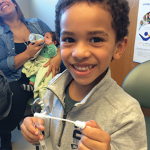Another speaker at the session, Laure Gossec, MD, PhD, professor of rheumatology at Pierre and Marie Curie University in Paris, noted that what physicians consider important outcomes may not match what patients consider most important. The scores that are used to rate the impact of RA have not always considered lifestyle issues most relevant to patients, such as pain, sleep and fatigue. She is working within OMERACT to ensure better assessment tools that capture the patient perspective. OMERACT, Outcome Measures in Rheumatology, has developed guidelines for patient participation in research and established a guide for including patient-reported outcomes.
PR-COIN, or Pediatric Rheumatology Care and Outcomes Improvement Network, is one network of rheumatologists, nurses, therapists, social workers and others at rheumatology centers who are creating a registry database to measure their performance and inform themselves about patient-centered outcomes associated with juvenile idiopathic arthritis (JIA). Esi M. Morgan DeWitt, MD, MSCE, associate professor at Cincinnati Children’s Hospital Medical Center, said during her presentation that several questions motivated the development of the collaboration, such as whether “all children with JIA are receiving the best care possible … and whether parents are getting the information they need about the treatment and care for their children.”
The learning network was launched in 2011 and includes 13 sites and 60 physicians; it now has more than 2,000 patients registered in the database. The institutions within the network share best practices and methods for a disease that has had wide variation in therapeutic approaches. Parents are partners in the system, helping PR-COIN teams understand the patient’s perspectives, particularly about arthritis-related pain.
The model for the network is one that works, Dr. DeWitt said. It focuses on outcomes because “you don’t know how you are doing unless you measure it. … [It is important to] build community, have network sites working together to learn best practices from each other … and use technology effectively by building a sustainable registry,” she said.
Shared decision-making makes sense when there are multiple medically reasonable options to choose from, she said. “You need to make sure that the patient’s and parents’ goals and preferences are expressed and that providers have research-based evidence.”
Kathy L. Holliman, MEd, is a medical writer based in Beverly, Mass.
Second Chance
If you missed this session, Translating Patient-Centered Outcomes to the Real-World Setting, it’s not too late. Catch it on SessionSelect: http://acr.peachnewmedia.com/store/provider/provider09.php.



